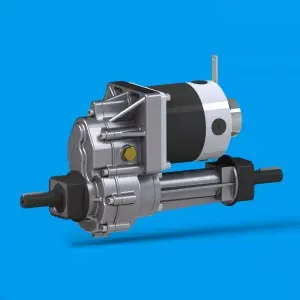When we zoom in on self-driving cars, we rarely stop to think about the complex mechanics that make it all possible. One of the important components is the transaxle. In this blog, we delve into the world of automatic transaxles to understand their purpose, mechanics, and importance in delivering a smooth, seamless driving experience.
What is an automatic transaxle?
To understand the concept of an automatic transaxle, we must first understand the difference between a manual transmission and an automatic transmission. In a manual transmission, the process involves the coordinated work of the gearbox, clutch and propshaft. However, in an automatic vehicle, a transaxle combines the functions of a transmission and a differential while ensuring power distribution and gear selection.
Mechanical principle of automatic transaxle:
The core components of an automatic transaxle include the torque converter, planetary gear set, belts, clutches and hydraulic system. Let’s explore each component to get a comprehensive understanding.
1. Torque converter:
One of the most critical components of an automatic transaxle is the torque converter. It acts as a fluid coupling between the engine and transmission. As the engine spins, a torque converter helps transfer power from the engine to the transmission, allowing for smooth gear changes and preventing stalling.
2. Planetary gear set:
Planetary gear sets are responsible for transferring power from the engine to the wheels. These gear sets consist of multiple gears, including sun gears, planetary gears, and ring gears. By engaging and disengaging these gears, the transaxle can change torque and ratio to suit different driving conditions.
3. Straps and clutches:
Belts and clutches are important mechanisms for engaging and disengaging gears within a transaxle. When a particular gear needs to be engaged, the hydraulic system controls the application and release of the band and clutch, allowing smooth transitions between gears.
4. Hydraulic system:
The hydraulic system plays a vital role by using hydraulic pressure to activate the belts and clutches of the transaxle. It consists of a pump, valve body and fluid channel network. The pump pushes transmission fluid through the channels, controlling gear engagement and ensuring efficient power transfer.
Importance of automatic transaxle:
The importance of an automatic transaxle lies in its ability to combine the functions of a transmission and a differential into one compact unit. By integrating these components, the transaxle simplifies powertrain design, reduces weight and improves fuel efficiency. In addition, it improves weight distribution and enhances vehicle handling and stability.
Another advantage of an automatic transaxle is its ability to automatically optimize gear ratios. By analyzing various factors such as speed, load and driver input, the transaxle selects the most appropriate gear ratio to provide smooth acceleration and higher performance.
in conclusion:
Although often overlooked, transaxles are the backbone of self-driving cars, ensuring seamless power transfer and gear selection. Understanding the mechanics of an automatic transaxle allows us to appreciate the engineering ingenuity that creates a comfortable and efficient driving experience.
The next time you hop in a self-driving car and revel in its effortless performance, remember the unsung hero at work beneath the surface—the automatic transaxle.
Post time: Jul-03-2023


